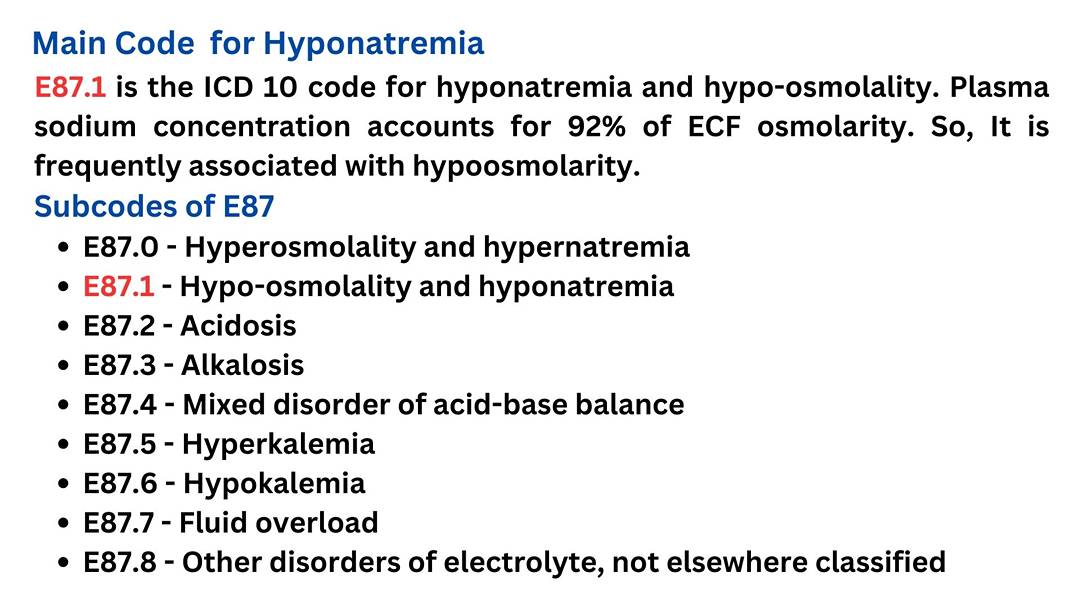
ICD 10 code for Hyponatremia
E87.1 is the primary ICD-10 code for hyponatremia and hypo-osmolality. Hyponatremia is a clinical disorder with plasma sodium concentration below 135 mmol/L. It is mostly due to water imbalance rather than sodium imbalance. It is frequently associated with hypoosmolarity.
E87 ICD 10 code is related to Other disorders of fluid, electrolyte, and acid-base balance. These include:
- E87.0 - Hyperosmolality and hypernatremia
- E87.1 - Hypo-osmolality and hyponatremia
- E87.2 - Acidosis
- E87.3 - Alkalosis
- E87.4 - Mixed disorder of acid-base balance
- E87.5 - Hyperkalemia
- E87.6 - Hypokalemia
- E87.7 - Fluid overload
- E87.8 - Other disorders of electrolyte and fluid balance, not elsewhere classified
E87.1 ICD 10 code for Hyponatremia and Hypo-osmolality
E87.1 is the ICD 10 code for hyponatremia and hypo-osmolality. E87.1 is also the ICD 10 code applicable for hypovolemic hyponatremia. This is applicable to hyponatremia (low sodium concentration in plasma), hyponatremia syndrome, and hypo-osmolality. Plasma sodium concentration accounts for 92% of ECF osmolarity. So, It is frequently associated with hypoosmolarity. E87.1 ICD 10 code is not applicable to the Syndrome of inappropriate secretion of antidiuretic hormone (SIADH). ICD 10 code for hyponatremia due to SIADH is E22.2.
Causes of hypovolemic hyponatremia:
- Gastrointestinal Sodium Loss: Vomiting, Diarrhea
- Renal Sodium Loss: Diuretic (esp. Thiazides)
- Skin Sodium Loss: Burns
Causes of Euvolemic hyponatremia:
- Primary polydipsia
- Excessive electrolytes-free water infusion
- SIADH (Syndrome of inappropriate secretion of antidiuretic hormone)
- Hypothyroidism
Causes of hypervolemia hyponatremia (Sodium retention with relatively greater water retention):
- Congestive cardiac failure
- Cirrhosis of liver
- Nephrotic syndrome
- Chronic Kidney Disease
Function of sodium
- Sodium accounts for 92% of ECF osmolarity and maintenance of the internal environment
- Sodium is concerned with resting membrane potential, action potential, and tissue excitability.
- Concerned with exocrine secretion
Clinical consequences of Hyponatremia
Most of the clinical effects of hyponatremia occur due to cellular overhydration i.e. (especially cerebral edema). Signs and symptoms start at a plasma sodium concentration less than 120 mmol/L. Initially, there was nausea, headache, lethargy, and malaise.
When the sodium level is less than 110 mmol/L, there will be drowsiness, confusion, stupor, coma, and even death.
Acute development of hyponatremia is more serious. Acute hyponatremia shows 29% incidence of convulsion and 50% mortality. Chronic development of hyponatremia is more tolerable because it allows time for osmotic adjustment between neurons and their surrounding ECF. So patient may be conscious even at plasma sodium less than 100 mmol/L. Chronic hyponatremia shows 4% incidence of Convulsion and 6% mortality.
Investigation done in hyponatremia
- Plasma electrolytes
- Plasma osmolarity
- Urine electrolytes
- Urine osmolality
- Measurement of plasma renin activity
Insight from Dr. Hafeez Merani, Chiropractor:
Dr. Hafeez Merani, an experienced chiropractor, emphasizes the importance of considering the musculoskeletal system's role in managing hyponatremia, especially in cases where patients experience neurological signs and symptoms.
"In patients with hyponatremia, particularly those with acute onset and neurological deficits, it's essential to assess their musculoskeletal condition as well. Musculoskeletal issues, such as spinal misalignments or joint dysfunction, can contribute to symptoms like headaches, lethargy, and even exacerbate neurological manifestations. As a chiropractor, I've observed cases where addressing spinal misalignments and improving nerve function through chiropractic adjustments has helped complement the overall management of hyponatremia."
Management of Hyponatremia with hypovolemic
The primary treatment of hyponatremia is the treatment of the primary cause. Oral electrolyte glucose mixture is given is mild hyponatremia with mild symptoms and advice to increase dietary salt intake.
- If the patient develops neurological signs, normal saline (0.9% NaCl) is infused
- 3% NaCl is infused if acute onset with neurological deficit
Management of hypervolemic hyponatremia with edema
For mild cases (Sodium 130 - 135 mmol/L), water restriction i.e. limit to 500 to 1500 ml per day with treatment of underlying disorder. For severe cases (Sodium < 124 mmol/L), continue water restriction and infusion of 3% hypertonic saline with diuretic therapy.
IV correction is done up to 126 mmol/L followed by oral correction. Not more than 10 mmol/kg body weight plasma sodium is corrected in a day.
The total sodium deficit is calculated by 0.6 x weight in Kg x (Desired sodium - Actual sodium).

Comments (0)